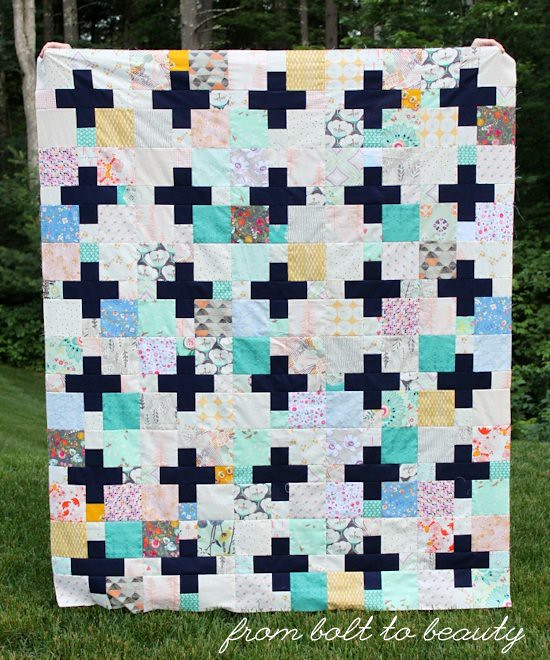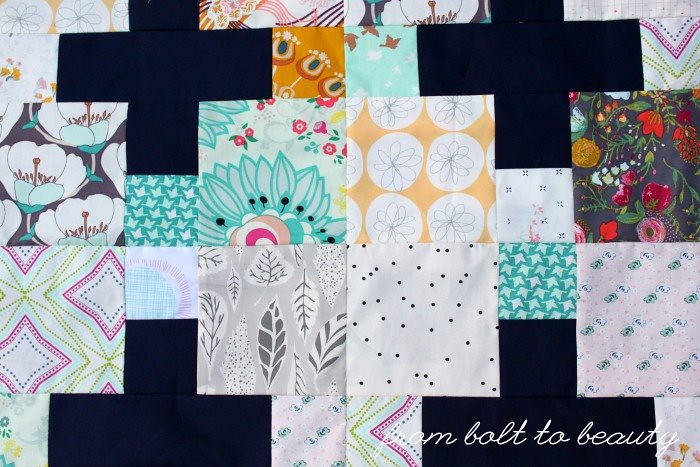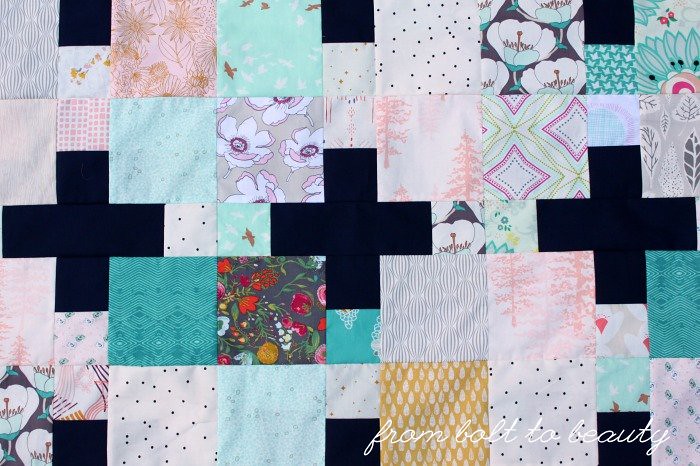I’ve been meaning to make an AG-only quilt for a while, something that would be a sort of cross-section of the company’s fabric lines. My friend Kim made a plus quilt back in 2015, using some AG charms from a swap I helped organize, and I loved it.
I had charms from the same swap, some scrappy bits from projects past (like this one and this one), and some yardage that I could play with. Almost all of it went into my quilt top.
Here is the finished flimsy, my first of summer 2017 ...
I’m pretty excited about the results. The quilt includes a lot of disparate fabric lines and colors, but I think it works. What follows is how I approached thinking about the fabric pull and the design.
Developing a Cohesive Palette
As I culled through the AG fabrics I had on hand—from tiny trimmings in my scrap bin to the large cuts in my stash—I noted the recurring colors. In particular, there were off-greens like teal and mint, mustard, grey, all shades of pink, and blues that bordered on periwinkle. Those colors were my lowest-common denominators, and I used them to judge whether fabrics made it into the quilt. That’s not to say that other colors were avoided; a particular fabric needed to contain some aspect of that palette.
This palette got me thinking. AG fabrics play so nicely together. They don’t coordinate color-wise like Cotton and Steel fabrics do, across designers and collections, but there is a modernness to AG’s color selections that is evident in its many fabric lines. This is a contrast to other manufacturers whose fabrics I buy. Take Moda, for example. There’s no common palette in its fabric collections, even those I consider to be more modern. Sure, it’s easy to spot a Bonnie and Camille palette or French General palette, but Bonnie and Camille fabrics do not play well with French General fabrics. This is not an earth-shattering revelation, just an observation of how different fabric manufacturers use color. : )
Establishing an Overarching Design
In my mind, this project is not a scrappy quilt—a fraction of the fabrics came from my scrap bin—but I found myself implementing the same strategy I would to make a scrappy quilt. I like to use a strong, predictable design when I’m sewing something scrappy, and the plus blocks here do the job well. (For the plus block pattern, see the image at the bottom of this page. Other scrappy quilts of my include Obsession and Good Day Sunshine.)
And I like to repeat certain fabrics—I’m convinced that simply using some fabrics again and again creates cohesion. That’s where my yardage came into play. Some fabrics are used for a just a block or two because that’s all I had in my scrap bin. When I had yardage that played into the palette I developed, I used those prints throughout the quilt top.
Using the Power of a “Bridge Color”
At QuiltCon 2017, in Savannah, I attended Tara Faughnan’s Playing with Solids workshop. This class promised to push us participants out of our color comfort zones. During our three hours together, Tara encouraged us to minimize unnecessary chatter and rely on our own instincts to develop two-color combinations quickly, without overthinking.
During this class, she mentioned what she called “bridge colors.” These colors—including hues like mustard, navy, and olive green—are super versatile. Using them can bring harmony to what may otherwise seem like a visual cacophony. (That’s my definition of the concept. I didn’t think to jot down many notes during the class!) Bridge colors are apparent in Tara’s recent finishes (see here), and I’d argue that my use of navy in the AG quilt works as a bridge color, creating cohesion between the main color palette and all the other colors that make an appearance.
The concept of bridge colors reminds me of articles I’ve read about—would you believe it?—bridesmaid dresses. I have worn my share of unflattering bridesmaid dresses, but some wedding-planning authorities encourage brides to dress their entourage in a color like navy, plum, or wine. Could those options be considered bridge colors because they work with most hair and skin colors?
Why do these bridge colors work in such different contexts? Could it be that they’re not straight-on blue, purple, and red but colors that have a depth and complexity? I’m not sure. It’s interesting, though, and I’ll be more mindful of my use of these colors in future quilts, for sure.
So do you think this quilt top works? Does any of my rationale ring true with you? Do you find yourself approaching projects of your own in a comparable way?
Linking up to Needle and Thread Thursday, Finish It Up Friday, and Let’s Bee Social ...



